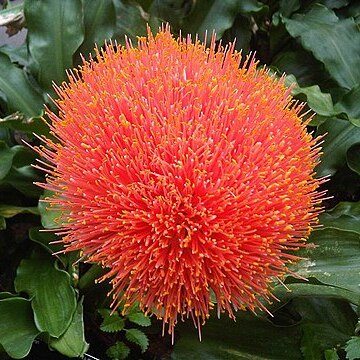Herb up to 75 cm. tall, with rhizomatous bulb.. Petioles forming a false stem 5–50 cm. long; leaf-blade lanceolate to ovate, acute to acuminate, basally attenuate; leaves often produced some time after anthesis.. Scape (15–) 20–40 (–75) cm. long; false stem and scape often spotted brown-red to dark violet.. Involucral bracts intact and erect during anthesis, lanceolate to spathulate or rhombic, sometimes hastate, (2.5–)3–8.5 cm. long, (0.7–)1–3.5 (–4) cm. broad, red (in East Africa) to brown, violet or even green.. Inflorescence conical, ±(20–) 30–100-flowered.. Pedicels 1–2.5(–3.5)cm. long.. Perianth colour pink to scarlet, outside East Africa also yellow-green and greenish pink, segments often paler than filaments; perianth-tube cylindrical, 0.3–1.2 cm. long; segments erect to somewhat patent, linear, 1.3–2.7 cm. long, 0.7–2(–2.5) mm. broad, (1–)3(–5)-nerved.. Filaments filiform, 1.5–3.5 cm. long at anthesis, anthers 1–3 mm. long, red or yellow.. Berries 5–10 mm. in diameter.
Perennial geophyte, 0.5-0.7 m high. Leaves dry or green at flowering, petiole-like base sheathing to form a false stem, blade lanceolate-ovate, 50-150 mm wide. Flowers in a dense, conical-hemispherical cluster, surrounding bracts suberect, as long as or longer than flowers, green to red; perianth ± tubular, 20-35 mm long, yellow-green to red; stamens and style slightly exserted. Flowering time Sept.-Jan.
Perennial herb, up to 0.75 m high. Leaves 2-7, forming a false stem by their sheathing parts, 5-500 mm long, free part of petioles < 100 mm long. Flowers: involucral bracts obvious, 30-85 mm long; perianth white and orange-red to pinkish; Sep.-Dec. Fruit a globose to ovoid, red berry.
Bulbous geophyte, 30-45 cm. Leaves 2-7, often dry at flowering, erect, petiole-like bases sheathing to form a false stem. Flowers in a dense, obconical head, red to salmon-pink, bracts usually more than 5, variable in size, pedicels longer than 10 mm.
Perennial herb, up to 0.75 m high. Leaves 2-7, forming a 5-500 mm long false stem by their sheathing parts, free part of petiole shorter than 100 mm. Involucral bracts obvious, 30-85 mm long. Flowers white and orange-red to pinkish.
A herb with a bulb. It grows 75 cm tall. The leaf stalks form a false stem 5-50 cm long. The flowers are in heads on long stalks. There are 30-100 flowers. The flowers are orange. The fruit are berries 5-10 mm across. They are red.

